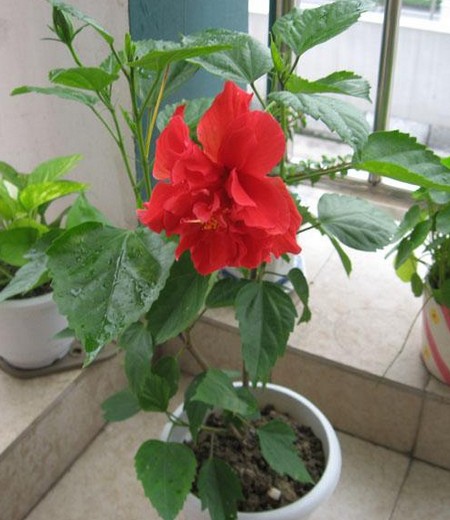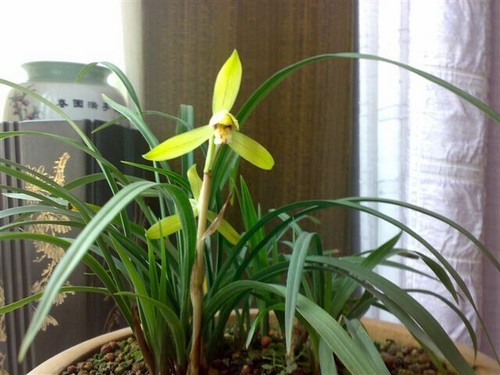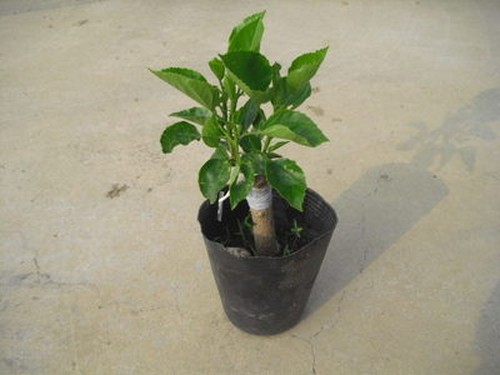Culture methods and matters needing attention of Fusang flower
Fusang is commonly known as hibiscus, also known as hibiscus, safflower, Chinese rose. Fusang is a beautiful ornamental flower with large color and long flowering period. in addition to red, there are different varieties, such as pink, orange, yellow, pink edge, red heart and white; in addition to single, there are double varieties. Potted mulberry is one of the best flowers for festive parks, flower beds, hotels, meeting places and families. Roots, leaves and flowers can be used as medicine, which has the effect of clearing heat and promoting diuresis, detoxification and detumescence.

Fiery red flowers, green leaves, various colors and single and double different petals, Malaysia's national flower, this is the Fusang flower. In the summer, Fusang flowers bloom the most prosperous, gorgeous color is the characteristics of Fusang flowers, so what are the breeding methods of Fusang flowers, how should households Fusang flowers? The beautiful Fusang flower has larger flowers and blossoms all year round, such as red, yellow, pink and so on. Like the humid, warm climate, the requirements of the soil is not strict, as long as it is not too cold, mulberry flowers will grow very well!
The flowers of the mulberry flowers are like an elegant woman dancing in a gorgeous dress. In summer, you can't help but indulge in the flowers of the trees and the full colors. If you also want to plant Fusang, then let the editor to tell you the breeding method and maintenance of Fusang!
[culture method of Fusang flower]
1. Soil: it can adapt to all kinds of soil, but the fertile and loose weak acid soil is the best.
Land selection and preparation: weak acid soil with sunny, warm and humid climate, fertile soil, loose drainage and good drainage.
2. Temperature: the optimum temperature for the growth of Fusang is 15-25 ℃ and 13-18 ℃ from October to March of the following year. The winter temperature should not be lower than 5 ℃, otherwise the leaves turn yellow and fall off. It is easy to suffer frost damage when the temperature is lower than 0 ℃, but it can still grow normally at high temperature above 30 ℃.
It must be moved indoors after Frosts Descent and before the Beginning of Winter, because Fusang is not resistant to frost. The overwintering temperature is not lower than 5 ℃ to avoid freezing injury, and not higher than 15 ℃ to avoid affecting dormancy. Cover paper or plastic film to keep warm when the weather is colder. The first moving room should open windows every day for ventilation, pay attention to the dry and wet changes of the basin soil, and water properly. In the coldest weather, watering can prevent frost injury, but fertilization should be stopped.
3. Sunshine: Fusang is a strong positive plant. Sufficient light is needed during the growing period in order to grow and bloom normally. If the light is insufficient, the bud is easy to fall off, the flower is small and the color is dim, but when the sun is too strong, the plant will burn, so it should be protected by shade properly. Fusang flowers like light, breeding sites had better be in sunny places, such as the south balcony, in the growing season of Fusang, to strengthen the management of water and fertilizer, Fusang flowers like water, many flower friends died of lack of water because of ignoring this point (do not like water, water desperately, according to the dry and wet soil). The main fertilizer application is thin fertilizer, which can be applied every 7-10 days. We should pay attention to less fertilizer in the later stage, so as not to sprout autumn shoots. Autumn shoot tissue is young, cold resistance is weak, cold weather will suffer frost damage.
4. Watering: keep the basin slightly moist during the winter. generally, the amount of water watered every 5 to 10 days should not be too much, so as to avoid root rot caused by low temperature and high humidity. The dry climate in northern winter will appear the phenomena such as yellowish leaf color and dry leaf edge, so we should pay attention to improve the indoor air humidity. Spraying and washing branches and leaves or covering plastic film can be used to increase the air humidity around the plant to create suitable humidity conditions for its growth.
5. Management: management is also very important. When you want to move outside and put it in a sunny place at the beginning of May, it is necessary to strengthen the management of fertilizer and water, loosening soil, pulling grass and so on. Apply dilute liquid fertilizer every 7-10 days, pay attention to the dry and wet condition of the basin soil when watering, too dry or too wet will affect flowering. Post-autumn management should be cautious, pay attention to less fertilization in the later stage, so as to avoid the emergence of autumn shoots. Autumn shoot tissue is young, cold resistance is weak, cold weather will suffer frost damage.
6. Change the basin: the basin should be changed before moving out of the house in April every year. Loose and fertile sandy soil should be selected. When changing the basin, we should also replace the new culture soil, cut off part of the overdense curly fibrous roots, apply sufficient base fertilizer, and slightly add phosphate fertilizer to the bottom of the basin.
7. Pruning: after being moved outside, pruning is carried out. Except for 2-3 buds at the base, all the branches are cut at the top. Pruning can promote the development of new branches, which will grow more vigorously and the plant shape will also be beautiful. After pruning, water and fertilizer should be properly controlled.
8. Prevention and control of diseases and pests: after entering the room in winter, if the indoor ventilation is poor and the light is insufficient, it is easy to be harmed by aphids and shell insects. Attention should be paid to improving the ventilation and light transmission conditions of the indoor environment combined with drug control. A small amount of shell worms can be gently brushed off with a brush. The main pests of Fusang are aphids, chaff, cotton blowing and mites (commonly known as red spiders). These pests are all prick-sucking pests. That is, they use their mouthparts to pierce the leaves or epidermis of plants to absorb plant juice. The leaves of the killed plants lost green and grew weakly, which reduced the ornamental value. After the occurrence of aphids and mites, aphids and mites can be diluted by a certain number of drugs, such as aphids and mites, and then foliar spray can be used to kill aphids and mites once a week, usually 2-3 times. Bran medium and cotton blowing medium can harm leaves and epidermis. Generally, imidacloprid drugs or their modifiers can be used to dilute a certain number of times, and then spray to kill the affected parts. The harm is serious, but once every 10 days, 3 times can be basically extinct.
Time: 2019-06-01 Click:
- Prev

How to raise spring orchids in the family
Chunlan is a typical representative of the petal flower of the national orchid, which has been widely spread since ancient times. Chunlan has a wide range of famous products with stable and moderate prices, which can be accepted by ordinary enthusiasts. But it is cheap to buy and expensive to raise. Take a look at how to raise Chunlan in the family! The environmental requirements of Chunlan: Cymbidium prefers a cool, half-yin and half-yang environment, and does not need much fertilizer.
- Next

How to cultivate potted mulberry flowers
The flowers of the mulberry flowers are like an elegant woman dancing in a gorgeous dress. In summer, you can't help but indulge in the flowers of the trees and the full colors. If you also want to plant Fusang, then let the editor tell you the breeding method and maintenance of Fusang.
Related
- Fuxing push coffee new agricultural production and marketing class: lack of small-scale processing plants
- Jujube rice field leisure farm deep ploughing Yilan for five years to create a space for organic food and play
- Nongyu Farm-A trial of organic papaya for brave women with advanced technology
- Four points for attention in the prevention and control of diseases and insect pests of edible fungi
- How to add nutrient solution to Edible Fungi
- Is there any good way to control edible fungus mites?
- Open Inoculation Technology of Edible Fungi
- Is there any clever way to use fertilizer for edible fungus in winter?
- What agents are used to kill the pathogens of edible fungi in the mushroom shed?
- Rapid drying of Edible Fungi

